April 2009
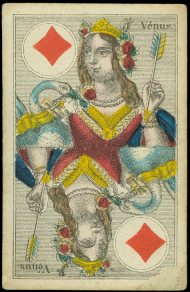 |
Because of "Queen's Day" we always have to wait
until the last day of this month, before we can decide which deck to put here.
That's the day on which there are free markets throughout the country, where
people can sell their stuff and you never know what you'll find amongst that. So
we did wait, but as expected, we didn't find anything that could surpass the
deck here below.
But Queen's Day wasn't the only event this month. Whenever the largest Dutch collectors fair is held in the
Jaarbeurs in Utrecht the chances are good that we'll find a deck there that will
make it to this page. Of course we did find some interesting things there
this time too, just like at the international meeting of the Dutch playing cards
and joker collectors. Ebay brought us some interesting decks and there was a
package from China again. So there was a large number of decks to choose from
this month, but none of the above could surpass the deck that was found at the
monthly flea-market in Utrecht, which was held during the first weekend this
time.
Once again we experienced that special buzz, when we opened a
cute antique box and saw this deck. On this flea-market there are a lot of
merchants, but also a good number of private sellers, it's about fifty/fifty.
And by the looks of the seller, he could be either one. But when we inquired about
the price, he turned out to be a private seller: it was a bargain, even
for the box alone. We skipped the haggling and immediately put the item in our
bag and a smile on our face.
|
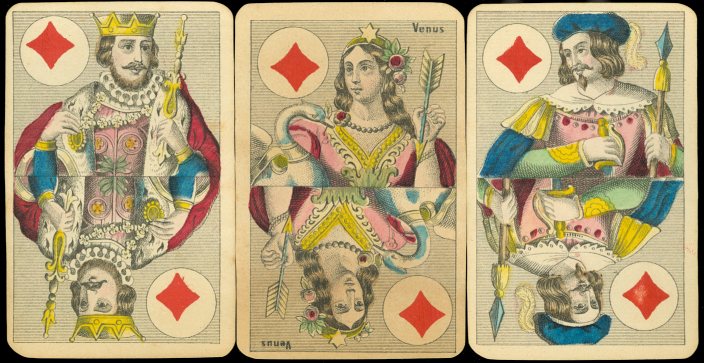
Dating and naming the deck, once we got home, turned out to
be a little more difficult than we had thought. It seems that this pattern has
been produced by several manufacturers and in different countries. In
Belgium the pattern is called "Cartes Suisses", probably because there
the pattern was often accompanied by Swiss scenic aces. The distinctive feature
of the pattern is the Queen. Each represents a Roman goddess. In Belgium this
pattern was produced in two styles. With a blank background and no names on the
Queens and in the style as shown here in this deck. The pattern has only
been popular for a few decades and it's hard to say which style came first or
where the origins of the pattern might lay.
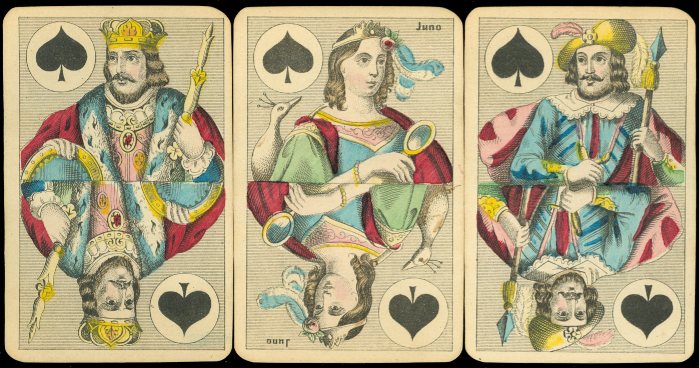
In our books about
playing cards we have found a few pictures of similar, but slightly different designed
decks. The insert card above is from a Belgian deck by Van Genechten from
Turnhout, probably made for the Walloon and maybe French market too, because an accent
grave (é) was used in Venus. We also found that the German manufacturer F.A. Lattmann had made
a deck with this pattern too. These decks are similar
to this style of the pattern, but with small differences in the designs.
The Van Genechten deck is dated 1870 (Han Janssen and E.
van Autenboer), the
Lattmann deck as ca. 1870 (Fournier Cat. II). If these dates are close to correct, then it's
hard to tell where the
origin of the pattern lies. Manufacturers often copied a pattern from each
other, when it was found to be a popular pattern elsewhere (in
Europe).
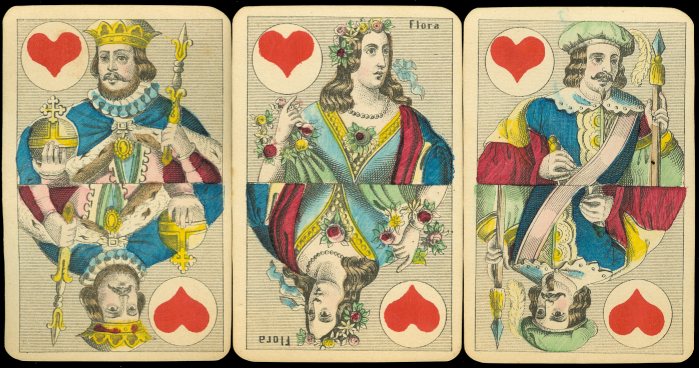
The names on the
Queens all refer to Roman goddesses:
- Juno is one of the oldest Roman goddesses,
wife and sister of Jupiter, and was not only worshipped as protector and
counselor of the state, but also as patroness of marriage. On the Queen of
Spades she is depicted with a peacock, in the antiquity a symbol of immortality.
It was emperor Adrian who placed a golden peacock with precious stones in the
temple of Juno, thus relating her with this bird for ever.
- Flora was the goddess
of flowers and spring in the Roman mythology. She was also seen as a fertility
goddess. So it's not a surprise that she's depicted on the Ace of hearts,
wearing strings of flowers.
- Diana was the goddess of the hunt, but also of the moon.
On the Queen of Clubs she's depicted with a bow and arrows and accompanied by a
dog. This is probably a hunting dog, but here the dog is looking up, away from
Diana, as if focused on something else. Perhaps the moon, and ready to start
howling?
- Venus was a
major Roman goddess, associated with love, beauty and fertility. She is depicted
with a swan, often a symbol of love and beauty, on the Queen of Diamonds while
holding an arrow. Being seen as the mother of Eros in some Roman mythologies the
arrow probably refers to the love-arrows that her son later used to enhance the
feeling of love between two mortals.
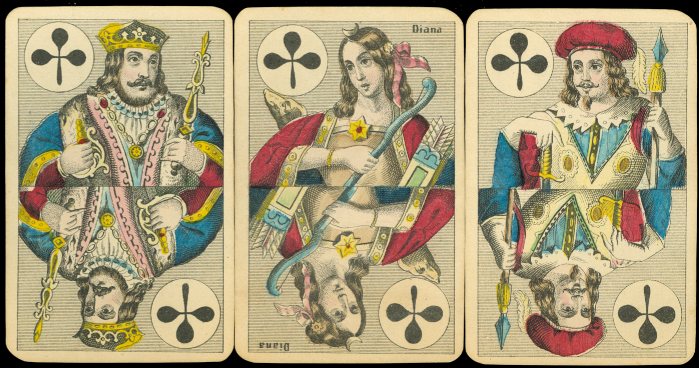
In spite of their
regalia and lances the Kings and Jacks are apparently such mortals. They remain nameless in
this pattern. And for now this deck will remain nameless too. Maybe a clever visitor
will be able to name the maker.
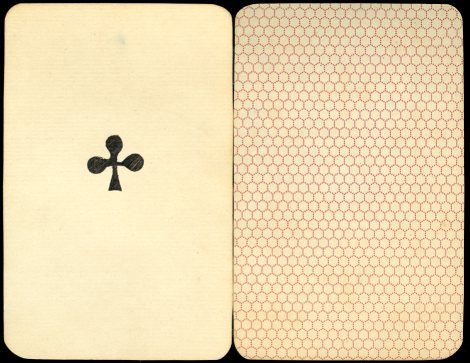
The deck consists
of 52 cards and has gold corners. The aces are plain and there are no indices or
numbers on the other cards.
BACK TO PRESENT MONTH





